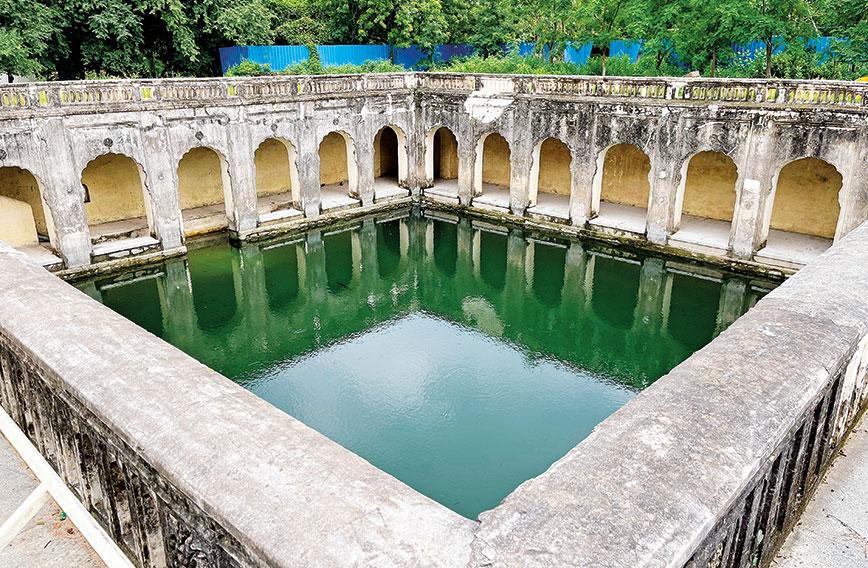
Baolis tumble out of Hyderabad’s past
Civil Society News, Hyderabad
FAR removed from its gleaming software parks and ambitious companies, a brooding necropolis on Hyderabad’s periphery is a reminder of a different kind of power and glory in an era long gone by.
Rulers of the Qutb Shahi dynasty, who once took the Golconda Sultanate to great heights of globalized prosperity, chose this peaceful corner of their tumult-riven and fractious empire to be laid to rest in tombs which were immersed in nature.
There were hundreds of acres of gardens and thousands of fruit trees to soothe them in death. An assured source of water for this greenery came from baolis or stepwells innovatively connected through an aqueduct to the Durgam Cheruvu, a freshwater lake near Hyderabad.
An ecological vision was at work here. The aqueduct brought water from the lake to a baoli in the west of the necropolis from where it went to the other baolis through a series of interconnections.
The grounds of the necropolis also sloped in a way that naturally took rainwater to the baolis and in addition, because of the gradient, ensured subterranean moisture for the plants and trees that surrounded the tombs.
 The Qutb Shahi tombs
The Qutb Shahi tombs
The Qutb Shahi tombs have for long been a landmark in Hyderabad. But the baolis were only discovered in recent years and restored as part of a conservation effort undertaken by the Aga Khan Trust for Culture (AKTC) since 2013 in partnership with the state government — then of Andhra Pradesh and now truncated to Telangana after a division.
The project was primarily meant to address the tombs where lie buried the key members of the Qutb Shahi dynasty that ruled the Golconda empire from 1518 to 1687 and founded the city of Hyderabad to serve as a capital beyond the Golconda Fort.
The tombs had been preserved, but just about so. They were in need of repair and more sophisticated conservation that would restore their original architectural qualities.
The necropolis was to be developed into The Qutb Shahi Heritage Park that would freeze-frame history for Hyderabad, all caught up in being a modern and aggressive city. A resplendent slice of the past would perhaps prompt present and future generations to pause and think about Hyderabad’s history. It would hopefully lead to better care of other pieces of heritage.
As conservation architect Ratish Nanda and his team ferreted around the tombs, the baolis came tumbling out of the necropolis’ long-buried past. It was a thrilling surprise. Conservationists treasure such aha! moments.
In all, eight baolis were identified of which six have been revived and are now full of water. Two have not been found though records show they existed. They are a wonderful discovery for their architecture and hydrologic design. They provide insights into the Qutb Shahis’ way of life, in particular their use of water.
The discovery of the baolis has resulted in present-day benefits in much the same way as they met the water requirements of the Qutb Shahis. The baolis now collect 20 million litres of water which meet the needs of the conservation project.
Till they were revived, water for the project work had to be bought and would arrive in tankers as it does for many big consumers in Hyderabad. It was costly.
All the water in the baolis comes from rainfall. The aqueduct that used to connect the baolis to the Durgam Cheruvu, the lake which was their chief source of water, has been unearthed, but it is not functional. The aqueducts linking the baolis to one another have, however, been revived, making it possible to move water from one to the next.
Says Nanda: “We had to buy water in tankers at Rs 2 per litre. Labour needs water and for chuna you need water. Then you need to do the gardens. We didn’t have an option but to buy our water though we realized that the cost was not sustainable. But last year, we used almost all the 20 million litres we collected during the rains. To be precise, we used about 18 million litres and we left some for the fish.”
Water, wealth, power
The Qutb Shahi dynasty ruled the fabulously wealthy kingdom of Golconda from 1518 to 1687, when it was erased by Aurangzeb. Remarkably, the dynasty reigned for an uninterrupted 169 years. It was founded by Sultan Quli Qutb-ul-Mulk, a Shia from Persia. His tomb lies in the necropolis, a few yards away from a hammam, or bath, which was the first structure to be built with a captive baoli to serve as a source of water.
 The Badi Baoli after it was restored
The Badi Baoli after it was restored
 |
| The collapsed state in which the Badi Baoli was found |
 |
| Restoration work in progress |
Scattered across the site are the tombs of Sultan Quli Qutb’s grandson, his third son, Jamsheed Qutb Shah, and his brother, Ibrahim Quli Qutb Shah. His successor, Muhammad Quli Qutb Shah, who laid the foundations of the city of Hyderabad, is also buried here along with the kings who followed. The last ruler, Abul Hasan, was imprisoned by Aurangzeb in Daulatabad and is not buried here. There are tombs of begums and commanders who fought wars for the kings.
The Qutb Shahis saw access to water as being indispensable to the wielding of power in a rain-starved and dry geography. They drew on replenishable local water sources in ways which modern economies are only now beginning to understand. They recognized that they needed water to flourish and it was important to only use as much as they could collect. For all the excesses of their reign, in this respect they showed a capacity for harmony and balance.
In death as in life, water was essential to their plans. The necropolis was under the gaze of the Golconda Fort, the citadel of the Qutb Shahis. The elaborate structures of their tombs were meant to be symbols of their status and glory.
But the tombs were not enough. An ambience of grandeur was required and what better way to provide it to a sarcophagus than by encasing it in the splendour of nature. Perpetual sources of water were needed for this arrangement.
The best laid out plans don’t, however, survive the ravages of time. With the end of the Qutb Shahi dynasty, the necropolis faded in importance as was only to be expected. With the neglect of the tombs, the baolis went into disuse. Their structures collapsed and they were filled up with mud. As a consequence, the trees and gardens disappeared.
For the longest time, Hyderabad has known the Qutb Shahi tombs to be just seven tombs sitting on a hundred acres. They were protected monuments, but this didn’t stop an amusement park from coming up in the late 1990s and with it the façade of the site was destroyed.
Starting out
In 2010, the state government asked the AKTC to develop the tombs as a heritage site. The Tata Trusts were ready to fund the project. The possibilities with the site interested the AKTC immensely, but Nanda took his time checking out what would be required.
Historical sites change in scale as a project progresses. It is best to assess them thoroughly before beginning. Nanda found on closer scrutiny there weren’t just seven tombs but 60 monuments to be restored at the site. The agreement he signed with the state government in 2013, all of three years after the initial moves, was therefore for a much more ambitious project than had been originally envisaged. Over the years, he says, the number of monuments at the site has gone up to around 100. Of these, 45 are mausoleums and the rest are other structures integral to the necropolis.
Nanda and his team come with vast experience and enjoy rockstar status internationally for their outstanding work on restoring Humayun’s Tomb and its surrounding monuments at Nizamuddin in Delhi where the conservation effort has also brought about the social and economic uplift of people living in the nearby Nizamuddin Basti. The basti was earlier just a neglected slum overrun by the drug trade. Equally outstanding has been the transformation of Sundar Nursery in the area.
Urban model
The AKTC’s role in Nizamuddin is essentially over. With the Qutb Shahi tombs, there is the prospect of developing another iconic site which is at the core of the identity of Hyderabad. People visiting the tombs will be able to experience heritage by way of recreation. The project is also better suited to serve as a replicable model for conservation elsewhere in India.
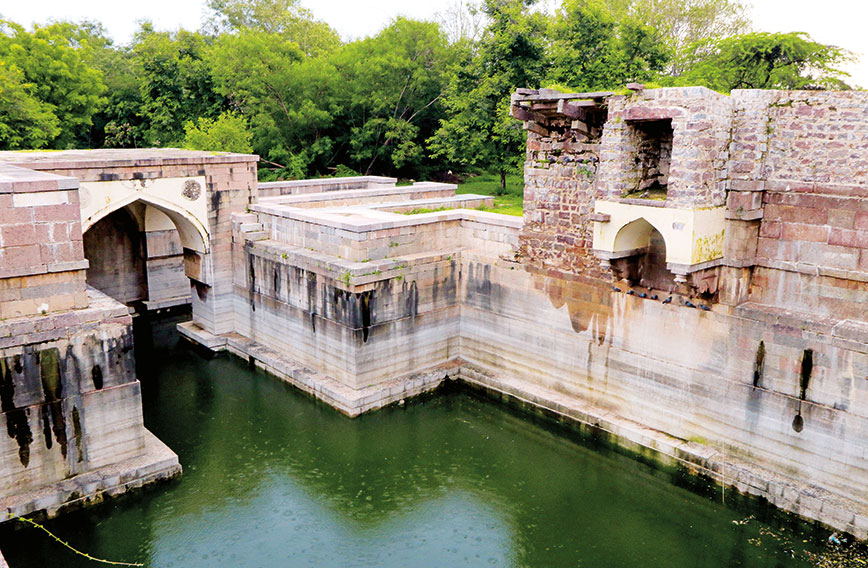 The Idgah Baoli brimming with water after restoration
The Idgah Baoli brimming with water after restoration
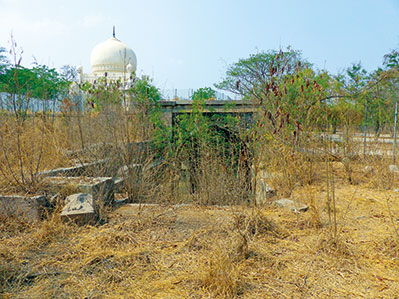 |
| The state of the Idgah Baoli when it was found |
 |
| The restored stairs |
“We like to do urban parks and there was real potential here for heritage and ecology to go hand in hand. Besides, it is a site of international significance. The Golconda Fort would have been too big, too complicated, not a park, too much archaeology. There was no other site to consider and we looked at many. This would have global impact,” he explains.
There are visitors who come in a dribble to the Qutb Shahi tombs. When the project is complete, Nanda believes their numbers will rise exponentially. The tombs will finally be such a significant landmark that they in themselves will be a reason to visit Hyderabad. This was the experience with Humayun’s Tomb and Sundar Nursery in Delhi where the number of visitors rose from 160,000 to two million a year.
“And I think that’s what is going to happen at Qutb Shahi. It’s going to become a magnet and an anchor. People will go see it and then see Golconda, the Charminar, and everything else. It is going to create that critical mass. The second thing is we are going to plant 15,000 trees out of which we have already put in 10,000. It’s going to become a green ecological hub which every city needs, not only Hyderabad. And then, of course, there is pride in the community,” says Nanda.
“It’s a major restoration for Hyderabad. It is the culture of the city which is being conserved,” says Sajjad Shahid, a heritage lover whose family has a 600-year association with Hyderabad.
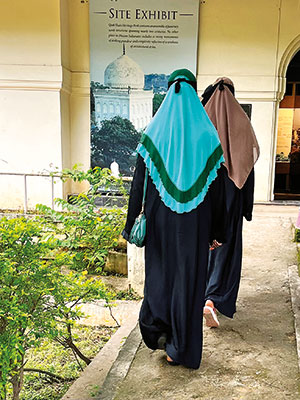 |
| Visitors to the Qutb Shahi tombs |
Shahid has helped AKTC decipher the evolution of the site and its significance. “Interest in local culture and history is being rekindled. The Deccan has always been more vocal about its regional identity,” says Shahid whose support and deep knowledge have been important for the project.
The opportunity with the Qutb Shahi tombs goes much beyond the footfalls. The project can serve as a conservation model for other cities. Urban areas across India have such opportunities to link their present to the past and use heritage for urban transformation.
Explains Nanda: “Our prime objective is to present a model. What was being done at Humayun’s Tomb-Nizamuddin in Delhi was not considered a model for all of India. The Hyderabad project is a model of how conservation can lead to an improved quality of life, how our heritage is an economic asset that can be leveraged and is, at the same time, a model of sustainable development.”
The choice of a project in Hyderabad was important for another reason as well. The city is a hub for the Aga Khan Development Network in India. The Aga Khan Academy has been set up here. The Aga Khan Health Services has a team working out of here.
Reviving baolis
Can the restoration of the baolis be a model for the revival of similar traditional water harvesting structures elsewhere in the country?
“It is a model for all of India. Across the country there are any number of water systems being revived. The rural employment program is providing unskilled labour. Ninety-nine percent of our traditional water systems are not working because they are silted. We removed truckloads of rubble from the baolis here. The rubble was reused because we are a zero-waste project,” says Nanda.
 The Eastern Baoli as it looks now
The Eastern Baoli as it looks now
The methods used in Hyderabad could well be replicated in villages and cities to revive tanks and stepwells that have been lying defunct. To build a new tank is expensive but to revive one and improve its efficiency requires more skills and technique than capital investment.
A baoli’s revival can be more complex than that of a tank because architectural, topographical and hydrological intricacies are involved. But the restoration work undertaken at the Qutb Shahi tombs shows what is possible if appropriate expertise is used.
“You need a historian, an architect and an engineer. You need someone who understands how water flows — a hydraulic engineer or a geotechnical engineer,” says Nanda.
A baoli is really a building that goes into the ground. When baolis collapse, they get filled up with mud. What else can be done with a hole in the ground? They then get built on or forgotten. Reviving them can’t be done either because structures have come on top or there isn’t the expertise and awareness available.
Says Nanda: “There were 100 stepwells in Delhi at the turn of the century. Now just 10 or 12 are left. They have all been filled. Some in front of my eyes. When I was a student documenting the Kotla Mubarakpur baoli it was filled up and so was Aurangzeb’s baoli. Buildings were made on them for their real estate value.”
Gardens and aqueducts
At the Qutb Shahi tombs, there is the Badi Baoli, Idgah Baoli, Western Baoli, Eastern Baoli, Hammam Baoli and the Bagh Baoli. Of these, the Badi Baoli was revived first for the purpose of conservation and has served as a demonstration model.
“It took us three years to fix the Badi Baoli and the Tata Trusts funded it. For the other five baolis we got $160,000 from the US Ambassador's Fund for Cultural Preservation. We put in 50 percent of the money ourselves,” says Nanda.
Both the Bagh Baoli and the Badi Baoli are elaborate structures. Bringing a baoli back into use is fraught with challenges. In the case of the Badi Baoli, there was an arcade which had been constructed later by Salar Jung. Before that the baoli was a hole in the ground. The water was pushing out the arcade because in the natural course the water would flow into the baoli. Getting the water to flow into the catchment of the baoli was a design challenge.
“Now what we have done is to divide the gardens with each baoli according to capacity. We’ve put in a whole irrigation system with pumps and pipes,” says Nanda.
“Originally all of them were interconnected. The Qutb Shahis took water from the Durgam Cheruvu lake to the Golconda Fort. From there an aqueduct with a connection took it towards the Western Baoli and then all the baolis were interconnected. They were probably lifting water from the Western Baoli and then putting it in the aqueducts and filling some of the other baolis,” says Nanda.
First the original Qutb Shahi aqueduct was found. It was cleaned up and made operational. Then the other aqueducts, which serve as a network, were identified and restored. Now all the baolis are functional and connected to one another.
“When we want to move water from one baoli to the next we use the pump. We have aqueducts and the rainwater also goes into the aqueduct. When we were repairing the baolis we had to lift the water and store it somewhere else so we had to make these interconnections work,” explains Nanda.
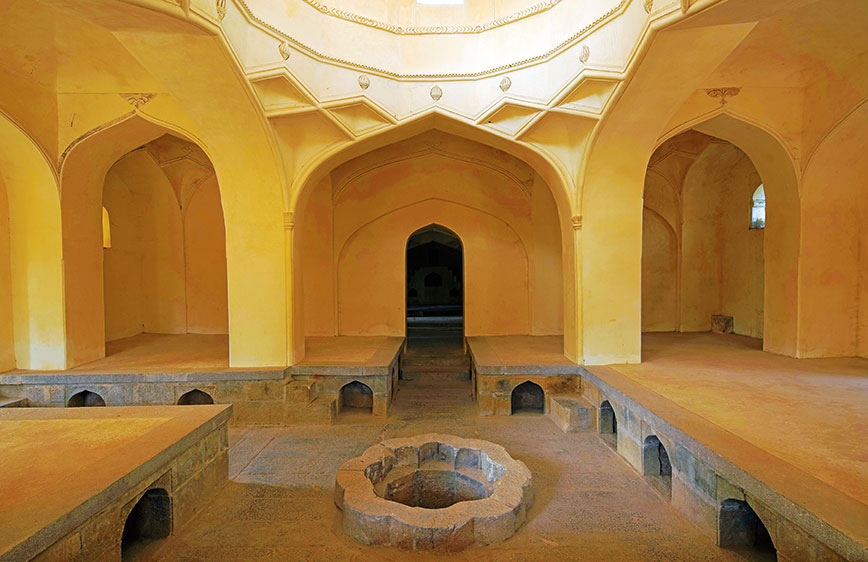 The hammam which was restored
The hammam which was restored
Unlike the baolis in Gujarat and Rajasthan, the baolis at the tombs are not very elaborate structures. They are mostly just dug-out structures meant to hold water. However, the Hammam Baoli, the Badi Baoli and the Idgah Baoli are more elaborate than the rest of the baolis and restoring them has been challenging. For instance, 600 cubic metres of stone had to be put back on one side alone of the Badi Baoli.
Steps, walls, ramps, arches and embellishments have had to be brought back apart from reviving the hydrological systems.
Nanda recalls: “When I went to Hyderabad, they all said to me, ‘These are the Qutb Shahis, they are not the Mughals, they don’t have any enclosed gardens.’ But we found this wall which didn’t seem to be going anywhere: it was the enclosure wall of the founder’s tomb. And then we found three enclosure walls. So, three of the biggest tombs were set in their own gardens. And the gardens had orchards and they needed water. Each of these three gardens had its own baoli. Now we were able to decipher the site.”
Not so varied
Nanda is hard- driving and known for his pursuit of perfection. He works with a full-time inter-disciplinary team — archaeologists, architects, engineers, horticulturists. Except for the baolis, which are unique, the rest of the structures are mostly similar.
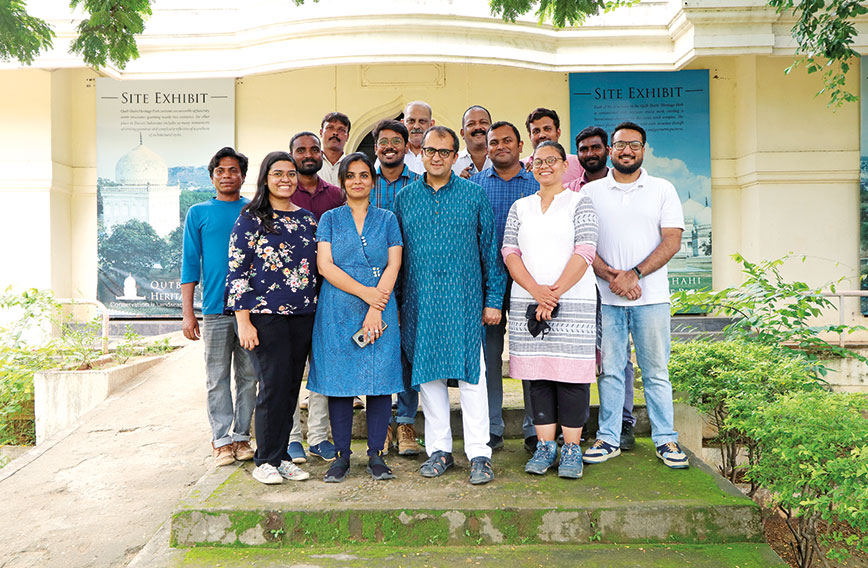 Ratish Nanda (centre) with team members
Ratish Nanda (centre) with team members
In the Qutb Shahi tombs, conservation has involved thinking about granite, stucco and ground levels. Ground levels, which had mostly been razed, had to be revived. The granite plinth had to be restored. The original stucco plaster had to be brought back. Cement which got used in earlier clumsy conservation efforts had to be removed from everywhere.
“The approach is very consistent, which is a big advantage — the quantity of work is enormous but it is repetitive in terms of approval, thinking, conservation, planning. For a very big tomb and a very small tomb, the effort is the same. The process is the same. We do these big reports so that people are able to learn from it,” says Nanda.
On the other hand, restoring smaller monuments is more expensive and time-consuming because the effort required is intricate.
At the project in Nizamuddin in Delhi, for instance, the “conservation philosophy” varied from one monument to another whether it was the Sundar Burj or the Chausath Khamba — among many others.
Nanda elaborates: “If at Humayun’s Tomb there was a red sandstone block which was slightly damaged and according to our craftsmen would not last more than 10 years, we would replace it. At Chausath Khamba each stone block was unique. So we had to repair every block of stone. At Rahim’s Tomb where people think we have redone the interiors, it’s all original. It’s really preservation — uncovering layers of cement, jaali, everything. Every monument needs thought.”
The experience in Nizamuddin, of course, serves well in Hyderabad. The tombs are in themselves less challenging but there is also the benefit of all the learning from having dealt with much more complex archaeological situations.
In Nizamuddin, craftsmen with traditional skills with stone were brought in from villages in northern states, giving them a new source of employment and drawing on the fine quality of their work. In Hyderabad such craftsmen were not available and those who worked in Nizamuddin have been used. There has been not only cross learning from one project to the next but also a transitioning of craftsmen.
The makeover at the Qutb Shahi tombs has taken more than a decade. Conservation is a slow and painstaking process of investigation, discovery and revival with many dividends. Fast moving cities can learn from their heritage to slow down a bit and think about where they are headed. Can they spend a little more time getting things right? Are they mindful enough of ecology? With the baolis and trees coming back at the tombs, there is now so much water that the project is creating an artificial lake. The tombs and baolis were for all practical purposes lying abandoned. Now they are on their way to being seen as glorious emblems of a progressive Hyderabad.
Comments
Currently there are no Comments. Be first to write a comment!



